
PROJECT
HYPERION
Design Competition Results 2025
Design for Centuries
Project Hyperion explores the feasibility of crewed interstellar travel via generation ships, using current and near-future technologies. A generation ship is a hypothetical spacecraft designed for long-duration interstellar travel, where the journey may take centuries to complete. The idea behind a generation ship is that the initial crew would live, reproduce, and die on the ship, with their descendants continuing the journey until reaching the destination. These ships are often envisioned as self-sustaining ecosystems, featuring agriculture, habitation, and other necessary life-support systems to ensure survival across multiple generations.
The Initiative for Interstellar Studies (i4is) is delighted to reveal the winners of the Project Hyperion Design Competition, a landmark global challenge that called upon interdisciplinary teams to envision a generation ship—a crewed interstellar spacecraft designed for a 250-year journey to a habitable planet. The teams designed habitats of such a spacecraft that would allow a society to sustain itself and flourish in a highly resource-constrained environment.
The Project Hyperion Design Competition required architectural designers, engineers, and social scientists to collaborate and address critical mission aspects that enable a spacecraft to function as a closed society over centuries. The collaboration between different disciplines is key to finding holistic solutions that do justice to the complexity of the requirements, in order to provide:
-
Habitability for 1,000 ± 500 people over centuries
-
Artificial gravity via rotation
-
A society that ensures good living conditions, including essential provisions such as shelter, clothing, and other basic needs.
-
Robust life support systems for food, water, waste, and the atmosphere
-
Knowledge transfer mechanisms to retain culture and technologies
More details about the competition requirements can be found here.

We thank our jury
The submissions were evaluated by our esteemed jury, comprising distinguished professionals with extensive experience in architecture, engineering, and social sciences.
1st Place
Team
Giacomo Infelise, Veronica Magli, Guido Sbrogio', Nevenka Martinello, Federica Chiara Serpe
Team statement
"The most difficult, but also interesting and stimulating part, was thinking about how the humans aboard the starship would live and conceive their existence over multiple generations. Chrysalis is not only a physical environment but also a cognitive space for the inhabitants: the phenomenological aspect of living and dwelling in the deep space, what is experienced, the psychological meaning of being a creature of the Cosmos is central in the design of the spaceship. Chrysalis is a living spaceship where humans, robots and artificial intelligent agents (AI-agents) share information, experiences and decision-making processes. The central core of our design regards the sense of belonging and the motivation of the interstellar mission: after a journey of hundreds of years, what will it be like to arrive in a new solar system and adapt to a new exoplanet?"
Jury feedback
Chrysalis impressed the jury with its system-level coherence and innovative design of the modular habitat structure but also overall depth of detail, which included, for example, in-space manufacturing and the value of pre-mission crew preparation in Antarctica. Its modular shell design promotes flexibility and connectivity, supporting both functionality and scalability. The large Dome structure adds a dramatic, cinematic quality that evokes science fiction classics, while the overall system-level planning—covering not just architecture but also how to build the vessel—is notably strong. The radiation protection strategy is solid, and the practical structural approach is well-suited. While cultural systems could be further developed, the concept offers a compelling starting point. The presentation is rich and visually engaging, drawing comparisons to iconic works like Rama, and showcasing a clear passion for both design and storytelling. Its overall spacecraft design seems to take inspiration from the gigantic world ship concepts of the 1980s.
2nd Place
Team
Julia Biernacik, Jakub Kot, Aleksandra Wróbel, Jacek Janas, Michał Kucharski, Wiktoria Kuchta, Natalia Łakoma, Katarzyna Śliwa
Mentor: dr hab. Michał Kracik
Faculty of Industrial Design (Design for Extreme Environments Studio) AFA in Krakow
Team statement
"Our concept tackled the challenge of designing a civilization capable of thriving during an interstellar journey. From the start, we knew no plan could anticipate every scenario, so we built our approach around self-actualization — creating environments that give future inhabitants the freedom to solve problems, adapt, and shape their own lives. Rather than recreating Earth, we aimed for spaces that would feel natural to those born on the ship or settling a new planet.
Meeting the TRL2 requirement meant focusing on early-stage yet technically plausible solutions. We kept the ship compact but comfortable, with general calculations for size, mass, structure, and energy ensuring feasibility over pure science fiction. The result is a vision of interstellar life that balances human-centered design with engineering realism."
Jury feedback
Commended for overall excellence, WFP Extreme has a particularly strong focus on cultural and societal dimensions, including concepts like clothing and spiritual spaces. It excels in its cultural and societal considerations, offering some of the most thoughtfully developed ideas in this area. The architectural design introduces advanced technologies such as radiation protection and demonstrates creative touches like the “taxi capsule” and personalized crew clothing. Though system-level coherence and interior design in artificial gravity could be further developed, the structural approach is well-suited to orbital applications. Overall, the project balances technical ambition with a unique and sensitive vision of future space living. This concept is clearly presented through a well-crafted booklet and poster, with strong attention to detail and a distinctive, human-centered aesthetic.
3rd Place
Team
Koshy Philip, Jan Johan Ipe, Amaris Ishana Mathen
Team statement
"The starship design itself represented an exercise in translating evolutionary design principles observed in Nature into a guide for engineering. We sought biomimicry examples applicable to deep space ("transformation within the context of the environment"), settling on the elegant simplicity of jellyfish (cnidarians)—one of the most ancient and robust multicellular marine organisms. While various other nuances exist, every design choice was directly informed by natural systems, deliberately favoring minimalism to reduce complexity and risk of failure. Finally, we attempted to anticipate human dynamics—whether cyclical or linear in nature—and prepared the crew (agents) for contingencies beyond our current foresight. To this end, we applied certain agent-based modeling (ABM) techniques using the Strauss–Howe generational theory as a 'structuring lens', constructing agentic archetypes (Prophets, Nomads, Heroes, Artists) and mapping their attributes and life cycles within the voyage. Every narrative element was considered as a parameter suitable for modeling."
Jury feedback
Systema Stellare Proximum distinguishes itself by its immersive storytelling, seamlessly tying together technical, social, and cultural aspects. This concept delivers a rich and imaginative narrative that thoughtfully weaves together social, technical, and cultural aspects of long-term space habitation. Its storytelling is engaging, with creative scenarios that explore community dynamics and even spirituality—emphasizing the role of shared values in building resilient, intergenerational societies. The use of an asteroid as a radiation shield is a bold and compelling strategy, paired with a visually striking structure inspired by the form of a jellyfish. While the physical feasibility of the thin-shelled asteroid could be further refined, the concept shows a solid understanding of cosmic radiation challenges. System-level planning is well-considered, and the presentation is detailed and visually dynamic, enhanced by artistic illustrations. This entry leaves a strong impression through its holistic vision and poetic approach to deep space living.
Honorable Mentions
Arkkana
(Link to submission)
Team
David Oliveira Silveira Junior, Natalia dos Santos Mesquita
Jury feedback
The design demonstrates thoughtful consideration of the time dimension and how the roles and needs of the population may evolve over the life of the habitat—an important and often underexplored aspect of long-term space settlement planning. The use of decoupled artificial gravity through counter-rotating rings is an excellent starting point, showing strong awareness of rotational dynamics and occupant comfort. While the rings are not concentric, which could potentially introduce unwanted torque due to offset centers of gravity, the concept still reflects a solid grasp of key mechanical challenges. The inclusion of maglev-supported habitat wagons enhances system redundancy and safety through multiple pressure vessels. The recognition that curved cylindrical modules would impose structural mass penalties, and the corresponding pivot to straight "sausage"-shaped modules with domed ends, shows a pragmatic engineering approach grounded in realistic structural constraints. Finally, the Mass/Equipment List (MEL) budgets represent a commendable early step in translating the conceptual architecture into quantifiable system requirements.
EBS: Endless Beyond the Stars
(Link to submission)
Team
Kyeongjun Na, Haesung Hwang, Hyeonguk Jeon, Hyeonsu Jang, Taemin Eom
Jury feedback
Galaxy Express 999 by EBS presents a well-considered approach to social organization, with a practical vision for internal modularity and adaptable living arrangements. The "Negotiopolis" concept is particularly compelling, offering an imaginative civic architecture and a negotiation-based governance model that introduces fresh perspectives on societal structure in an interstellar context. While the design is lighter on technical implementation, it contributes meaningfully to the broader discourse by emphasizing the importance of civic and social aspects. The artificial gravity concept is fundamentally sound, and the linear arrangement of pancake modules along the axis shows clear intent toward modular scalability. Although the pressure vessel design has some limitations—flat-ended cylindrical modules would face significant stress under pressure, requiring heavier structural reinforcement—there is awareness of this issue, as evidenced by partial attempts at incorporating domed ends. A refinement of this aspect, especially for end modules and during descent phases, would strengthen the structural logic. The internal modular system is sensibly developed and shows promise for flexible habitation. Inclusion of a Mass/Equipment List (MEL) would further support the design's technical depth, but the overall concept stands out for its imaginative and socially rich framework.
F.A.O.C. first asteroid O'Neill colony
(Link to submission)
Team
Antonio Azzolino, Alexandre Goulart, Bianca Montesanti, Juliana Matos, Luciano Ferraresi
Jury feedback
F.A.O.C. presents a strikingly original and compelling concept by embedding a rotating habitat within a mined asteroid shell—a bold architectural move that addresses key deep space challenges with elegance. The approach to radiation protection is particularly noteworthy, standing out as the most robust solution among all entries by leveraging the asteroid's natural mass for shielding. At a systems level, the proposal shows strong conceptual coherence, especially in its vision for interstellar transit and long-term habitat protection. The underlying idea of repurposing an asteroid as both a protective shell and a rotational structure is highly promising and grounded in sound reasoning. The interior storytelling, symbolic layering, and nods to ecological sustainability enrich the narrative quality of the project, making it memorable. F.A.O.C. offers a visionary and well-anchored starting point for future exploration.
Team
Tharshan Maheswaran, Lina Salman, Sergio Santaeufemia Sánchez, Mario Butscher, Jovana Stojković, Branko Drčelić, Seraphine Arnold, Franziska Maier, Anja Rieker, Vanessa Schwaiger
Jury feedback
Helios Ark stands out for its technically and socially comprehensive submission. It demonstrates an exceptional integration of detailed propulsion and life-support systems with robust governance structures, psychological support strategies, and thoughtful mission-phase planning—altogether presenting a design that plausibly supports human life across a 250-year interstellar journey. The architectural layout, featuring three stacked rings behind a wide frontal shield, shows a strong effort to balance artificial gravity and protection. While there are some unresolved questions regarding the interface between inner and outer toroids—particularly how they rotate relative to one another and to any potential non-rotating central axis—the design shows an awareness of the challenges in managing multiple rotational systems. More detailed elaboration of torque balance and spin-up mechanics would improve technical coherence, especially in terms of energy efficiency and long-term operational stability. The large forward shield is a notable feature, offering some protection from frontal impacts. Further consideration of omnidirectional threats in the high-velocity space environment would strengthen the defensive strategy. Overall, Helios Ark remains a standout for its rare balance of engineering depth and human-centered planning, making it one of the most credible and complete visions in the field.
Orion
(Link to submission)

Team
Elliott Orion Ruzicka, Anna Dovliatidou, Eden Buch Kornreich, Sean Wessels, Thomas Bjelkeman-Pettersson, Sam Ross, Moa Råhlander, James Boullion
Jury feedback
Neo-Genesis Seed presents a usefully novel design that balances conceptual depth with practical simplicity. Its drum-shaped architecture, featuring an ellipsoidal pressure vessel, reflects a sound approach to both structural integrity and artificial gravity. The design avoids unnecessary complexity while still incorporating a number of thoughtful and feasible features. Notably, the pressure vessel concept is robust, though the reliance on a single large volume highlights the need for an articulated emergency protocol in the event of a pressure breach—an area worth further development. The thermal management system is particularly distinctive, proposing a creative solution that acknowledges the limitations of convection in an artificial gravity environment. The submission's strength lies in its integration of biocultural systems, ecological logic, and generational storytelling. This holistic perspective on human resilience, mental health, and societal continuity positions Neo-Genesis Seed as a standout in conceptual vision.
Principium Hereditatis
(Link to submission)
.jpg)
Team
Chisomo Phiri, Nobukhosi Ngwenya, Lynette Thabo, Mongezi Ncube, Kasalina, Uvir Hansraj
Jury feedback
Principium Hereditatis presents a richly symbolic and culturally nuanced vision of interstellar life, distinguished by its strong narrative structure, ritual design, and emphasis on storytelling. The sequential modular habitat design—featuring elongated rotating toroids—supports a compelling conceptual arc that aligns the architectural layout with the emotional and psychological phases of embarkation, journey, and arrival. The artificial gravity system appears plausible, demonstrating a thoughtful application of rotational dynamics. The highly elliptical minor cross-sections of the toroidal structures would require substantial reinforcement to counteract the natural tendency of internal pressure to deform them into circular shapes, resulting in significant mass penalties. Overall, the proposal succeeds in offering a poetic and human-centered perspective. Principium Hereditatis' cultural depth and innovative ritual framing make it a valuable and thought-provoking contribution to the conversation on interstellar habitat design.
STASS Associazione Professionale
(Link to submission)
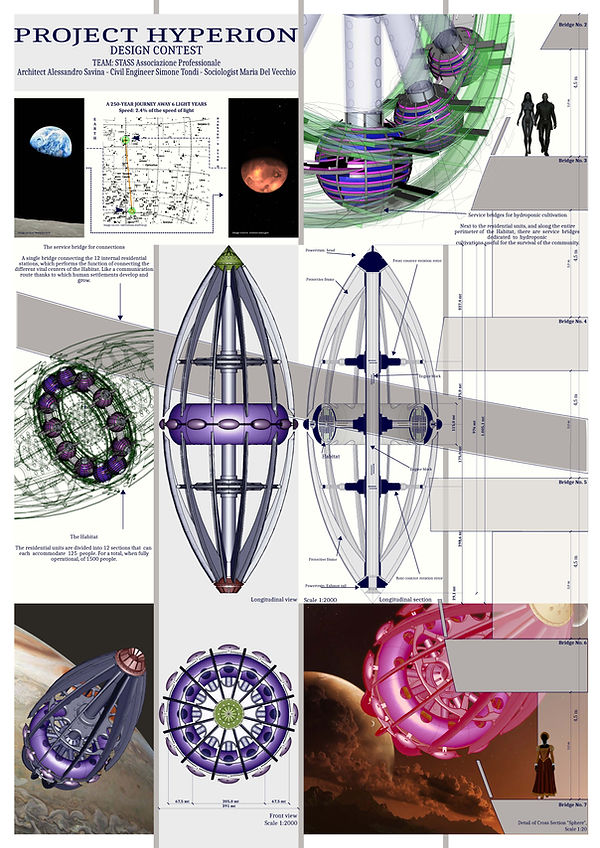
Team
Alessandro Savina, Simone Tondi, Maria Del Vecchio
Jury feedback
STASS presents a thoughtful and imaginative design supported by a well-articulated methodology and a solid structural overview. One of its most distinctive features is the inclusion of the Five-Point Knowledge Transmission System, which adds a meaningful cultural and educational dimension to the concept—ensuring continuity of knowledge and identity over generations. The design demonstrates good system-level coherence, with particular strengths in its approach to artificial gravity: a rotating toroidal volume paired with two counter-rotating flywheels, enabling efficient spin-up and spin-down using electrical energy rather than propellant. This is a technically sound and elegant solution that enhances long-term sustainability. While the elongated football-shaped geometry provides a striking visual identity. Radiation and impact protection strategies are addressed, including consideration of current TRLs, though the radiation shielding appears less robust compared to leading entries. The use of elliptical minor toroid cross-sections presents potential structural inefficiencies due to internal pressure forces that coulb e mitigated by the integration of residential spheres. Culturally, the concept leans into a somewhat mythical aesthetic. However, many of its themes—particularly those related to legacy and intergenerational knowledge—are highly relevant to interstellar missions. The interior designs contribute to an evocative and atmospheric presentation. The final layout is clean, visually engaging, and easy to navigate. Overall, STASS stands out for its narrative richness and coherent systems thinking, with room for further refinement in structural and radiation strategies.
The Belgian Space Hikers
(Link to submission)
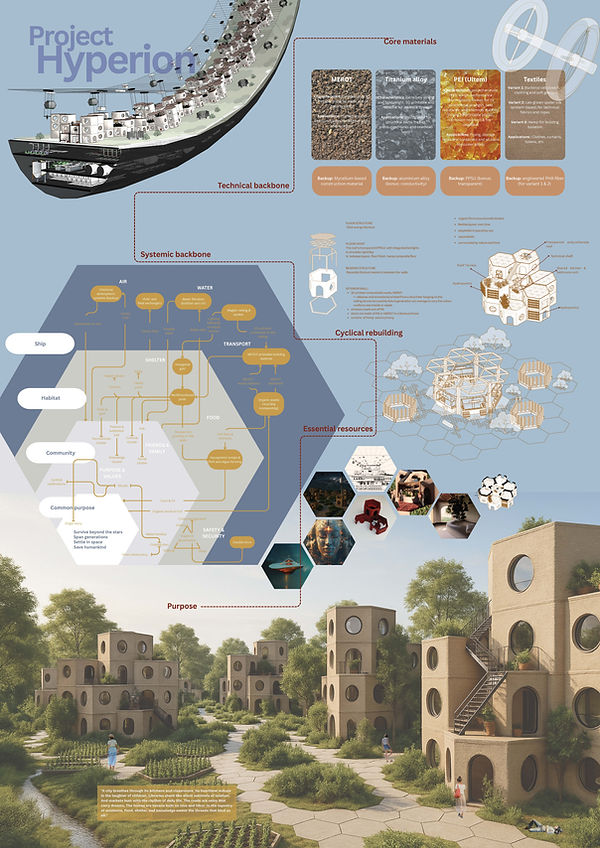
Team
Jan Beeldens, Caroline Gerard, Natalie De Backer, Pieter Verberck, Jan Van den Broeck, Brecht Caers, Eva Verhelle, Eva Burm, Jonathan Van Cauwenberge
Advisors: Erwin Verstraelen (VP Innovation Port of Antwerp-Bruges), Johan De Greeve (Sr. Director Engineering KLA ICOS Division), Marleen Ramaekers (Accountmanager Plastics2Chemicals at Indaver), Tom Monballiu (International networks manager Port of Antwerp-Bruges), Christophe Roes (E&I engineering Director at Agidens), …
Jury feedback
The Belgian Space Hikers provide a highly creative and well-presented design that ranks as one of the top submissions. It stands out for its exceptional balance and completeness, showcasing a strong integration of architectural innovation, social systems, and technical feasibility. The dual-torus habitat, combined with layered AI governance and thoughtfully designed educational and civic spaces, reflects a mature and holistic approach to interstellar living. While it may not push the boundaries with radical innovations, its clarity, coherence, and attention to detail across all domains establish it as a model of design excellence. The internal modular habitat system is particularly well-developed, supporting adaptability and long-term habitation. Although more detailed drawings of the rotating toroids and overall vessel design would aid in deeper technical evaluation, The Belgian Space Hikers impress with their well-rounded and practical vision.
undagila
(Link to submission)

Team
Made Wigana, Bonar Yeshurn, Steven Gilberto, Naradhipati Andaru
Jury feedback
Sriwijaya is a creative and well-presented concept that offers a deeply poetic and culturally immersive vision. It thoughtfully emphasizes intergenerational continuity, ritual, and symbolic heritage, crafting a socially resilient and meaningful culture suited for a long-duration mission. While the technical systems are not extensively detailed, the proposal excels in its focus on the human and cultural dimensions of interstellar habitation. The design may incorporate a rotating ring structure, though the drawings seem to leave this open. The internal modular habitat system is well-developed, supporting flexible and adaptable living spaces. Additional detailed drawings of the overall vessel would help provide a clearer technical assessment. Overall, Sriwijaya stands out for its rich cultural narrative and strong social vision.
WeSpace
(Link to submission)

Team
Fatemeh Mosavi, Nafise Etemadi Idgahi, Saeed Vahdani, Negar Radfar, Elham Yousefi, Ahmad Eltaf Zhian, Mobina Fallah Gavareshk, Fatemeh Barzegar, Negar Ahmadpour, Ali Seddighi, Mahdieh Hosseinpour
Jury feedback
This submission offers an interesting and ambitious design, with modularity as a core concept—an approach that generally supports flexibility and resilience. It stands out as one of the most integrated proposals seen so far, demonstrating strength across architecture, engineering, and social systems, and embodying the spirit of envisioning a generation ship that balances speculative vision with system-level coherence. The DNA-shaped vessel and the arrangement of globular habitats linked in a spiral pattern are visually and conceptually intriguing. The pressure vessel design is solid, and the artificial gravity approach appears generally sound, though some visual elements—such as people walking on the zero-g core cylinder walls—may overstate the effective gravity in those areas. The abundance of AI-generated images contributes to a striking but somewhat disjointed presentation; many visuals lack clear correspondence to detailed drawings. The mission control center design also feels somewhat unconventional, with its wide floor facing a circular windshield, which may merit further reconsideration. Overall, the submission impresses with its ambitious scope and integration. It may benefit from clearer technical documentation and tighter alignment between visuals and engineering details.

About Us
Project Hyperion works on a preliminary study that defines integrated concepts for a crewed interstellar starship or generation ship. The study aims to provide an assessment of the feasibility of crewed interstellar flight using current and near-future technologies. It also aims to guide future research and technology development plans as well as to inform the public about crewed interstellar travel.

We are an international, interdisciplinary team with expertise in architecture, engineering, anthropology, and urban planning.
We've had the privilege of working with some of the biggest names in R&D, including NASA, ESA, and MIT. Our expertise in interstellar travel has earned us a reputation as leaders in our field.





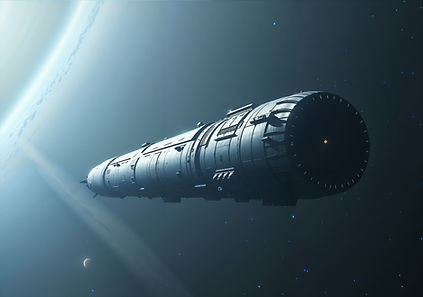

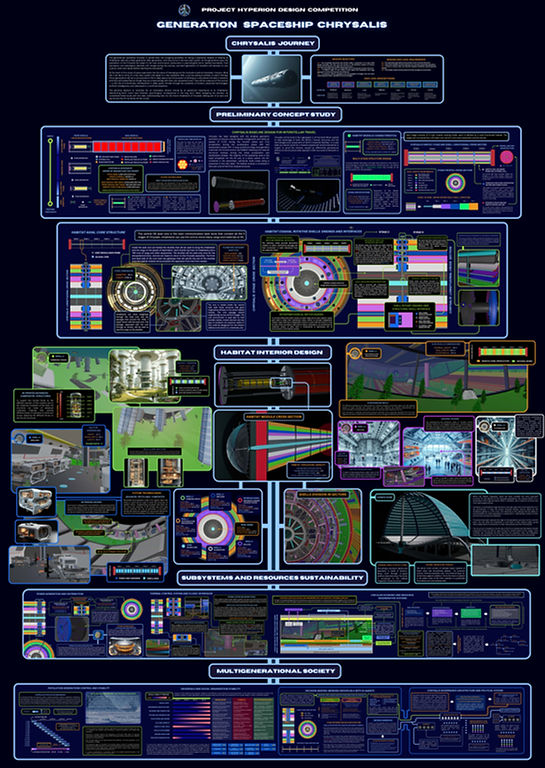

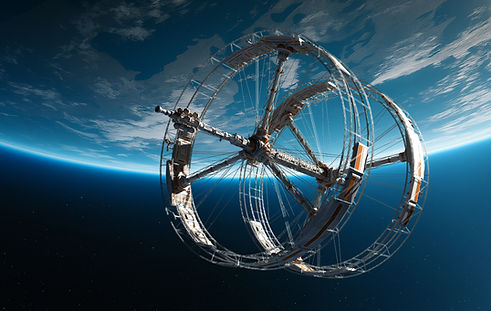



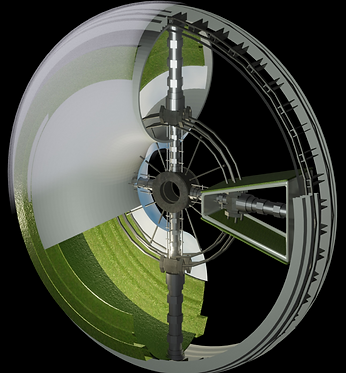
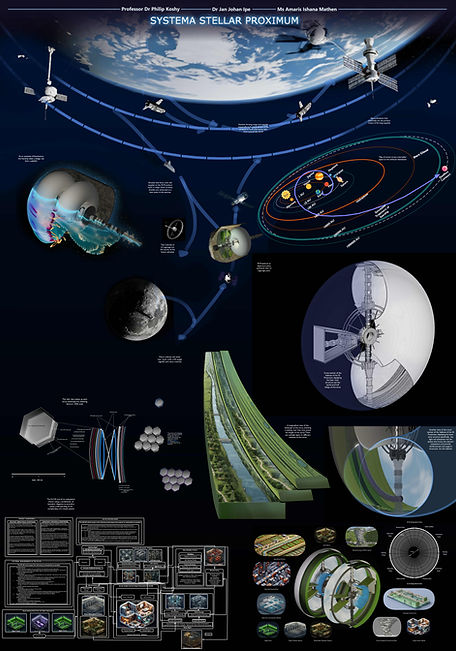




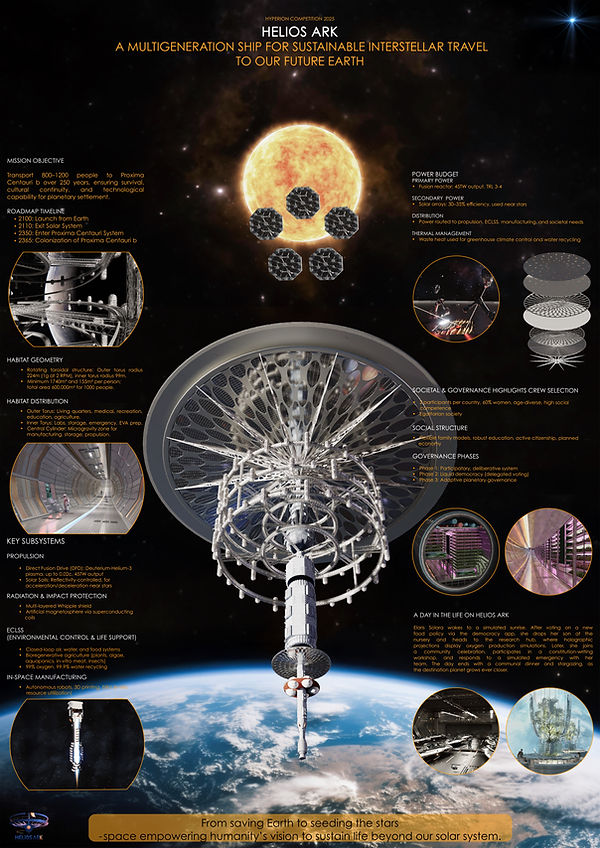





.jpg)


